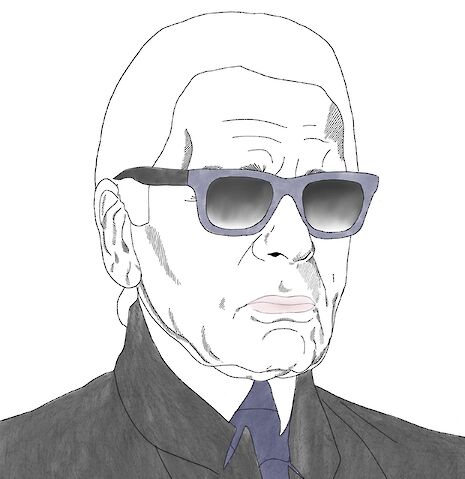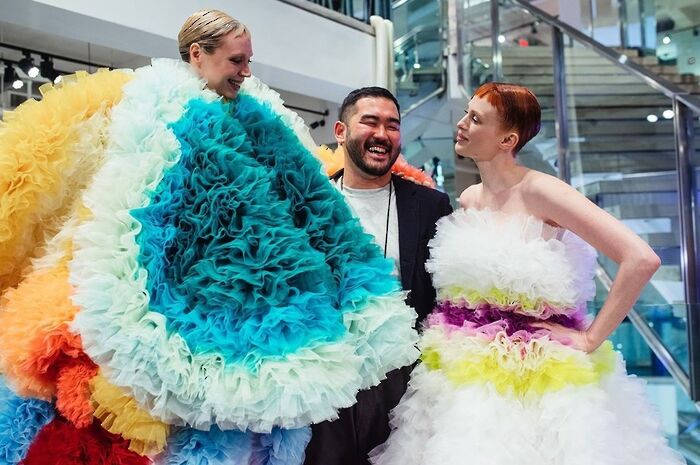Deconstructing Karl
Caterina Bragoli examines the illusive man behind the famed fashion house.

Just the day before Karl Lagerfeld’s passing, I was at a talk given by two leading figures of Chanel International, including Dr Berndt Hauptkorn, European President of Chanel. The way in which Lagerfeld was presented as the very core of the brand was extremely powerful. Dr Hauptkorn seemed to brush competing fashion houses aside, simply because they were not fuelled by the creative vision of Lagerfeld. Lagerfeld invigorated the brand with an unparalleled timelessness, sophistication, and elegance that would never be compromised; he furthered Gabrielle ‘Coco’ Chanel’s legacy while simultaneously defying fashion’s boundaries. If Coco was the beating heart of the brand, Lagerfeld was the blood that ran through its veins.
Disconnecting Lagerfeld from Chanel is challenging. After all, he had been Chanel’s creative director since 1983. However, tracing his immense career back to its foundations offers a glimpse into the ground-breaking creative path that led to his innovation of Chanel. Lagerfeld was no stranger to the hardships of breaking into the fashion industry: after winning a coat-designing contest in 1955, he progressed to the position of Pierre Balmain’s assistant. Balmain is credited with offering Lagerfeld his first big break, influencing his career by introducing him to the art of tailoring, or ‘Architecture of the Movement’, as Balmain aptly phrased it. Lagerfeld put this training into good use when designing for Chanel: he is credited with defying the set silhouettes that were associated with Chanel, instead reviving the 1920s designs by shortening hem lines, injecting vibrant colours and monogramming the most unlikely garments.
The pioneering and career-crafting position for Lagerfeld that truly established his name in the industry was his work with the Italian fashion house Fendi. This collaboration began in 1965, manifesting in a bold and striking way for over 50 years. Lagerfeld himself said that “It’s the longest collaboration in fashion”, a testament to how invaluable and instrumental his creative direction was. A specific element of the brand that Lagerfeld reinvented was their fur — a questionable pursuit in today’s society, but in 1965 was ground-breaking and unparalleled. High fashion had never encountered the likes of rabbit or squirrel pelts before, yet Lagerfeld managed to incorporate these unique textures into his designs, placing Fendi – with their newly crafted, mirrored FF logo – at the forefront of the modern industry. Lagerfeld’s quest for experimentation can be said to be more prominent in his work with Fendi than with Chanel. While Gabrielle Chanel’s feminine vision is the ultimate priority for the brand, Lagerfeld and the Fendi sisters had no rules to adhere to, catapulting the brand to an internationally recognisable status.
Lagerfeld and Chanel will forever walk hand-in-hand in fashion history, and for good reason. Following the death of Gabrielle Chanel, the fashion house suffered immensely from a lack of creative vision as well as a problematic over-investment in the fragrance side of the brand. Designers were merely replicas of the sentiment that Gabrielle had left behind: nothing new was revitalising Chanel’s collections. Lagerfeld took Gabrielle’s ideas and elevated them to new heights. He used the brand’s focal points – tweed and the colours of black, pink and gold – and revolved his collections around them, constantly reinventing the classics such as the 2.55 bag or their tweed blazer. But Lagerfeld didn’t stop there: he breathed new life into classic designs by incorporating the power of street culture into them. The classic ideal of Chanel was merged with an eclectic mix of street style and grunge, placing Chanel on an unreachable pedestal, explaining the autonomy the brand has today.
"The black sunglasses, scraped-back silver ponytail, and meticulously put together suits are just a few of the factors that contributed to the overall – somewhat intangible – image of Lagerfeld"
Lagerfeld’s mark has been left on every aspect of Chanel as a brand, most importantly their shows, which are the things of legend. Lagerfeld and the Chanel production team had an ability to transport an audience out of Paris or New York and into a pseudo-reality of dreams. Recently, in the Couture Spring/Summer 2019 collection show, Chanel built a Italian lakeside mansion – Villa Chanel – and accompanying gardens, making summer tangible in the very air of the show. Autumn/Winter 2018 saw the models walking down an enchanted forest runway, complete with fallen leaves in various shades of green and brown. Lagerfeld even managed to erect a giant Eiffel Tower in the Grand Palais for the Couture Autumn/Winter 2017 collection. The merging of fashion with insanely crafted, unbelievably real settings will never be replicated without the eye of Lagerfeld. He knew exactly what kind of environment would allow his clothing to reach its full potential, meticulously manipulating locations to compliment the power of his collections, while crafting an audience experience that only Chanel could offer.
These astounding career feats form only one half of Lagerfeld. A fundamental reason why his image was extolled as the epitome of high fashion was his very essence as a designer, and the intricately crafted illusive personal image. Lagerfeld famously said “I am like a caricature of myself, and I like that”. The black sunglasses, scraped-back silver ponytail, and meticulously put together suits are just a few of the factors that contributed to the overall – somewhat intangible – image of Lagerfeld. He transcended the boundaries of normality or regularity, shunning the concept of imperfection with an image oozing with class, elegance and creativity. This renowned image had an immense sense of personality on the surface, yet what did it really offer us with regards to the person that Lagerfeld was? Perhaps that was Lagerfeld’s ultimate aim: to reveal the crux of himself through his designs. The ever-evolving collections were compounded by the consistency of his image, creating a paradoxical dynamic that has never before been encountered in the history of fashion, and most likely never will be again.
But preserving the legacy of fashion’s greatest force is a complex task. Lagerfeld has always been a prominent vocal proponent of his desired aesthetic: fashion for slimmer figures. Chanel itself appeals to a certain idealised woman: beautiful, thin, perfect. Lagerfeld took this concept and created a brand for himself that alienated the women that couldn’t conform to his standards. This prompts debate over the coveted status of Lagerfeld, and why he was afforded such reverence despite his outdated notions, when the likes of Edward Enninful were employing trans columnists and including women of diverse backgrounds on his Vogue covers. Lagerfeld has been branded misogynistic in the days following his death, and you don’t have to search far to find out why: calling Adele ‘too fat’ or claiming his collection with H&M could only be worn by ‘thin people’ suggests a hatred for anything less than his perfection. In an ever-changing climate, there is no room for Lagerfeld’s standards. Fashion embraces a spectrum of female beauty – perhaps not until recently, but change is ushering its way in – and Lagerfeld was promoting the ideas of decades past. Fat shaming is never acceptable, not even when coming from the mouth of fashion’s greatest legend. Offering no compromise or accessible options for the vast majority of women suggests something callous about his view of women.
Who was Lagerfeld? This illusive caricature offered the world’s prying eyes no access into the goings-on of his personal life but just a glimpse of his beloved cat, Choupette. ‘I never thought that I would fall in love with a little cat like this,’ said Lagerfeld early last year, in an interview with Vogue. Is that the real key to deducing Lagerfeld’s character? Amid the fortune and glamour of his flamboyant lifestyle – he did have five homes – a cat as his life partner seems to suit his particular lifestyle.
"I never thought that I would fall in love with a little cat like this"
One aspect of Lagerfeld’s life was that he was uncompromisingly protective over his age. Lagerfeld claimed for decades that he was younger than he actually was. “You know, the youth obsession is a kind of racism,” he commented in the same interview. Lagerfeld’s breezy use of the term racism here suggests a lack of understanding as to the political climate of modern society. He thought it acceptable to bring this into a discussion over his refusal to set the record straight over his age. This was just one aspect of the illusion of Lagerfeld: he was infallible in the world of fashion, and seemingly also to himself.
It is a rare gift to be utterly overcome with passion for your work, and nowhere is there a better example of work being both a pleasure and an indulgence than in the decades-long career of Lagerfeld — so much so that fashion and Lagerfeld are indistinguishable from each other. And yet, the truth is rearing its head, forcing the sycophantic fans of Chanel and Lagerfeld to come to terms with the reality of the man behind the garments.
 News / Eight Cambridge researchers awarded €17m in ERC research grants27 December 2025
News / Eight Cambridge researchers awarded €17m in ERC research grants27 December 2025 News / Downing investigates ‘mysterious’ underground burial vault 29 December 2025
News / Downing investigates ‘mysterious’ underground burial vault 29 December 2025 Lifestyle / Ask Auntie Alice29 December 2025
Lifestyle / Ask Auntie Alice29 December 2025 Sport / Hard work, heartbreak and hope: international gymnast Maddie Marshall’s journey 29 December 2025
Sport / Hard work, heartbreak and hope: international gymnast Maddie Marshall’s journey 29 December 2025 Interviews / Meet Juan Michel, Cambridge’s multilingual musician29 December 2025
Interviews / Meet Juan Michel, Cambridge’s multilingual musician29 December 2025










